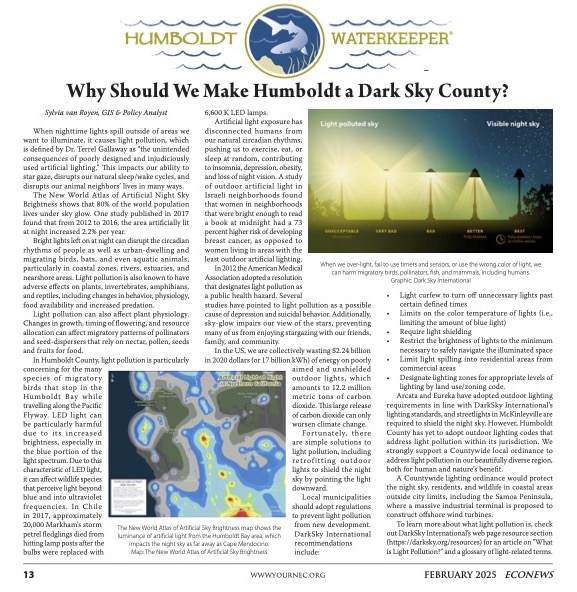
When nighttime lights spill outside of areas we want to illuminate, it causes light pollution, which is defined by Dr. Terrel Gallaway as “the unintended consequences of poorly designed and injudiciously used artificial lighting.” This impacts our ability to star gaze, disrupts our natural sleep/wake cycles, and disrupts our animal neighbors’ lives in many ways.
The New World Atlas of Artificial Night Sky Brightness shows that 80% of the world population lives under sky glow. One study published in 2017 found that from 2012 to 2016, the area artificially lit at night increased 2.2% per year.
Bright lights left on at night can disrupt the circadian rhythms of people as well as urban-dwelling and migrating birds, bats, and even aquatic animals, particularly in coastal zones, rivers, estuaries, and nearshore areas. Light pollution is also known to have adverse effects on plants, invertebrates, amphibians, and reptiles, including changes in behavior, physiology, food availability and increased predation.Light pollution can also affect plant physiology. Changes in growth, timing of flowering, and resource allocation can affect migratory patterns of pollinators and seed-dispersers that rely on nectar, pollen, seeds and fruits for food.
In Humboldt County, light pollution is particularly concerning for the many species of migratory birds that stop in the Humboldt Bay while travelling along the Pacific Flyway. LED light can be particularly harmful due to its increased brightness, especially in the blue portion of the light spectrum. Due to this characteristic of LED light, it can affect wildlife species that perceive light beyond blue and into ultraviolet frequencies. In Chile in 2017, approximately 20,000 Markham’s storm petrel fledglings died from hitting lamp posts after the bulbs were replaced with 6,600 K LED lamps.
Artificial light exposure has disconnected humans from our natural circadian rhythms, pushing us to exercise, eat, or sleep at random, contributing to insomnia, depression, obesity, and loss of night vision. A study of outdoor artificial light in Israeli neighborhoods found that women in neighborhoods that were bright enough to read a book at midnight had a 73 percent higher risk of developing breast cancer, as opposed to women living in areas with the least outdoor artificial lighting.
In 2012 the American Medical Association adopted a resolution that designates light pollution as a public health hazard. Several studies have pointed to light pollution as a possible cause of depression and suicidal behavior. Additionally, sky-glow impairs our view of the stars, preventing many of us from enjoying stargazing with our friends, family, and community.
In the US, we are collectively wasting $2.24 billion in 2020 dollars (or 17 billion kWh) of energy on poorly aimed and unshielded outdoor lights. Which amounts to 12.2 million metric tons of carbon dioxide. This large release of carbon dioxide can only worsen climate change.
Fortunately, there are simple solutions to light pollution, including retrofitting outdoor lights to shield the night sky by pointing the light downward. Local municipalities should adopt regulations to prevent light pollution from new development. DarkSky International recommendations include:
- Light curfew to turn off unnecessary lights past certain defined times
- Limits on the color temperature of lights (i.e., limiting the amount of blue light)
- Require light shielding
- Restrict the brightness of lights to the minimum necessary to safely navigate the illuminated space
- Limit light spilling into residential areas from commercial areas
- Designate lighting zones for appropriate levels of lighting by land use/zoning code
Arcata and Eureka have adopted outdoor lighting requirements in line with DarkSky International’s lighting standards, and streetlights in McKinleyville are required to shield the night sky. However, Humboldt County has yet to adopt outdoor lighting codes that address light pollution within its jurisdiction. We strongly support a Countywide local ordinance to address light pollution in our beautifully diverse region, both for human and nature’s benefit.
A Countywide lighting ordinance would protect the night sky, residents, and wildlife in coastal areas outside city limits, including the Samoa Peninsula, where a massive industrial terminal is proposed to construct offshore wind turbines.
To learn more, check out our Light Pollution Factsheet or visit DarkSky International’s explainer on What is Light Pollution? and their Glossary of light-related terms.


